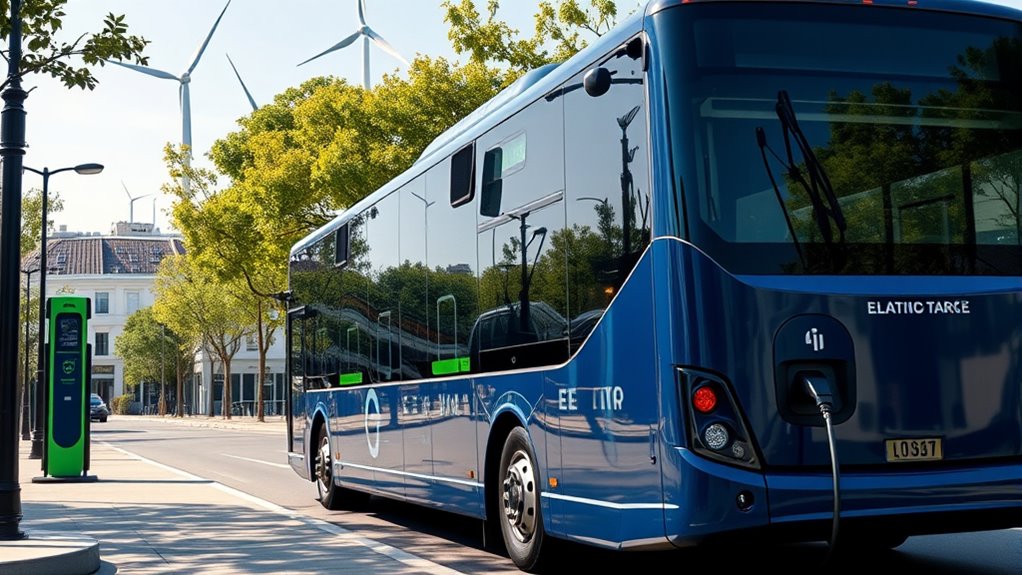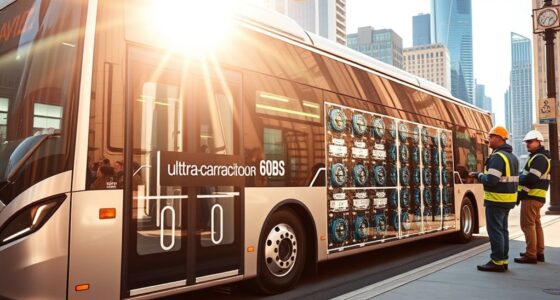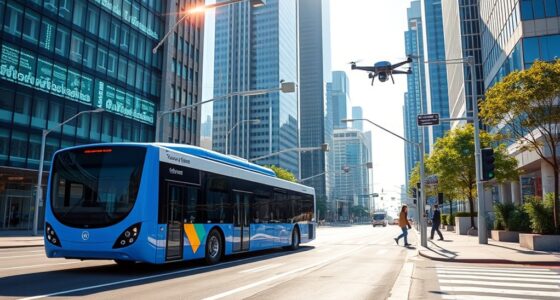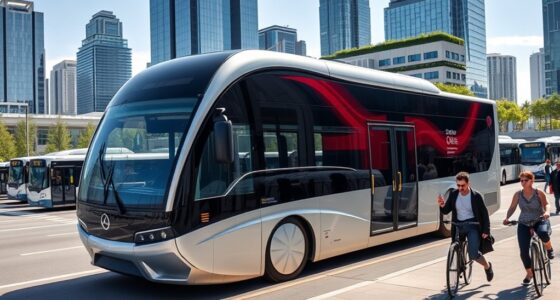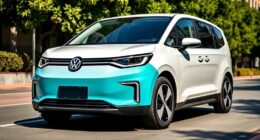Electric buses play a key role in the shift toward sustainable transportation by cutting emissions, improving air quality, and reducing noise pollution. They support economic growth with savings on fuel and maintenance while creating green jobs. Technological advances like longer-lasting batteries and fast charging make them more reliable. Policies and infrastructure investments further accelerate adoption. To see how these factors combine to transform urban mobility and contribute to a greener future, keep exploring.
Key Takeaways
- Electric buses significantly reduce greenhouse gas emissions and local pollutants, aligning with broader climate and air quality goals.
- They support urban decarbonization efforts by replacing diesel fleets, contributing to national and global sustainability targets.
- Advancements in battery and charging technologies enable efficient, reliable, and scalable electric transit systems.
- Infrastructure development and policy incentives foster the integration of electric buses into comprehensive sustainable transportation networks.
- Their adoption promotes public health, noise reduction, and social equity, reinforcing the shift toward healthier, more livable cities.
The Environmental Rationale for Electric Buses
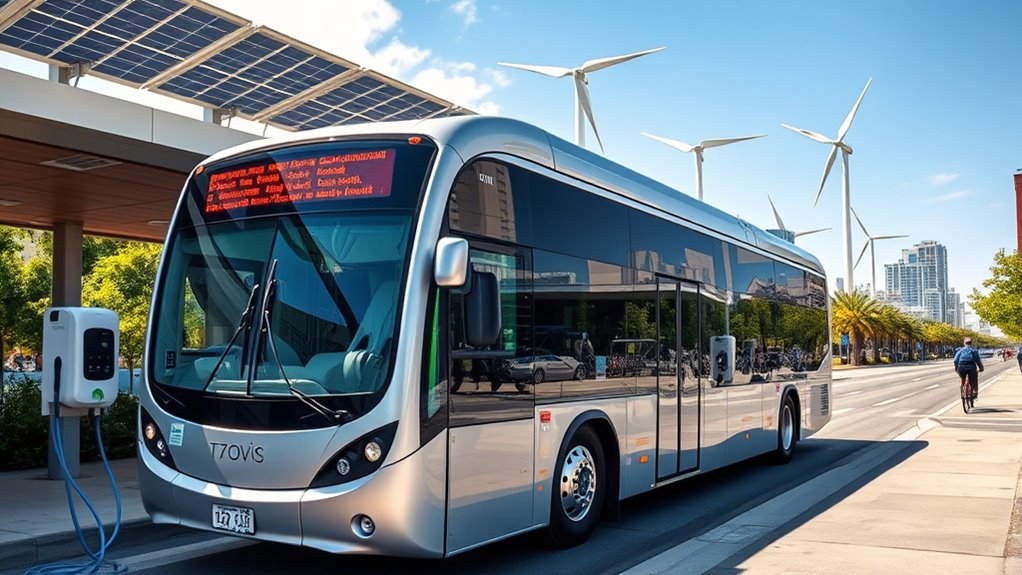
Electric buses offer a compelling environmental advantage because they produce zero tailpipe emissions during operation. This means you won’t see or breathe in harmful pollutants like nitrogen oxides (NOx) and particulate matter (PM2.5/PM10), which are linked to respiratory diseases.
They also protect vulnerable populations, including children and drivers, from roadside and in-cabin exposure to dangerous fumes. Since electric buses don’t burn fuel, they eliminate localized greenhouse gas emissions, directly improving urban air quality.
As a result, cities experience cleaner air immediately in high-traffic zones, reducing health risks and supporting healthier communities. By removing combustion byproducts, electric buses help combat climate change, reducing around 181 metric tons of CO2 per bus each year.
Their zero-emission operation offers a crucial step toward more sustainable, healthier urban environments. Additionally, the integration of refrigeration cycle technologies in electric buses can further optimize their energy efficiency and performance. Implementing emission reduction strategies in transportation infrastructure complements the benefits provided by electric buses, further advancing urban sustainability. For example, advancements in fuel cell technology contribute to cleaner energy solutions that can be integrated into future transportation systems.
Economic Incentives Driving Adoption of Electric Vehicles
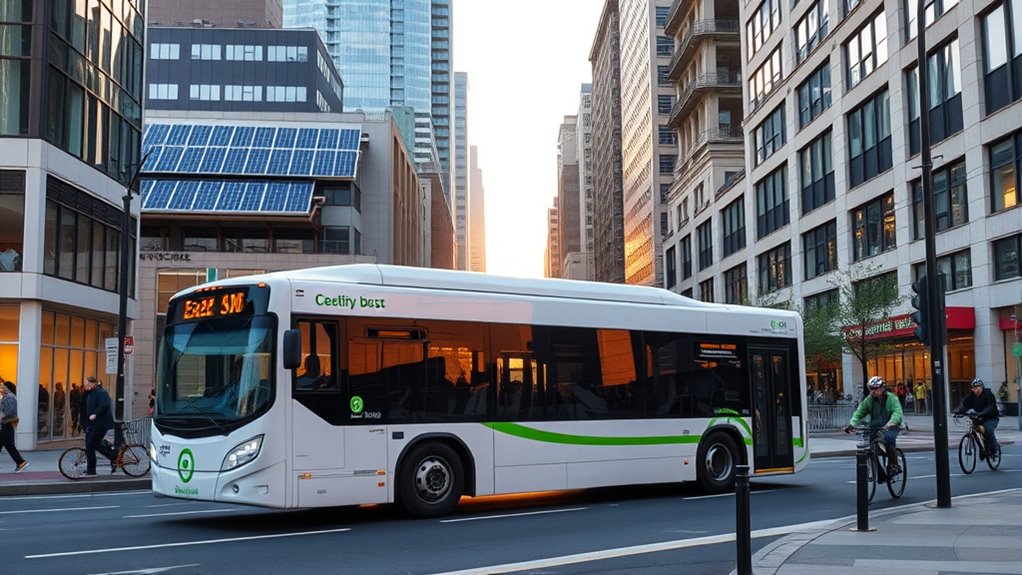
Financial incentives play a crucial role in accelerating the adoption of electric vehicles, making them more accessible and appealing to you. For every $1,000 in purchase rebates, you could see an 8% rise in new EV registrations. Federal tax credits up to $7,500 considerably lower upfront costs, while most states offer additional incentives.
These incentives not only boost demand but also promote long-term market growth, leading to economies of scale and lower production costs. They offer economic savings, too — reducing fuel expenses by $6,000 to $12,000 over a vehicle’s lifetime and cutting maintenance costs. Market growth is further supported by increased consumer awareness and technological advancements, making electric vehicles a more viable option for many.
Additionally, the subtopic of best anime movies highlights how diverse genres and high-quality storytelling can attract wider audiences, similar to how incentives broaden EV appeal. These financial benefits, combined with government policies supporting infrastructure and manufacturing, encourage more consumers to choose electric vehicles, fostering a shift toward sustainable transportation.
Technological Innovations Enhancing Electric Bus Performance

Advancements in battery technology are transforming electric bus performance by enabling longer ranges, faster charging, and lower costs. New battery chemistries increase energy density and cut charging times, making buses more efficient and practical. Battery upgrades further enhance energy storage capabilities, contributing to extended vehicle range and improved operational reliability. Innovations in battery design improve energy storage and extend vehicle range, reducing the need for frequent recharging. These improvements also help lower overall costs, making electric buses more affordable for transit agencies. Enhanced battery efficiency decreases energy consumption and boosts operational time. Plus, batteries are becoming more recyclable and sustainable, aligning with environmental goals. Additionally, smart infrastructure with integrated monitoring systems optimizes energy management and maintenance, further enhancing operational efficiency. Fast-charging solutions allow buses to recharge quickly during short stops, boosting operational efficiency. Wireless charging and smart infrastructure further streamline energy management, ensuring electric buses operate reliably and sustainably across diverse transit networks. Furthermore, the integration of AI-driven management systems is optimizing energy use and predictive maintenance, which is crucial for large-scale deployment. Moreover, ongoing research into recyclable battery materials aims to reduce environmental impact and improve sustainability in battery production.
Policy Measures Supporting the Transition to Electric Transit
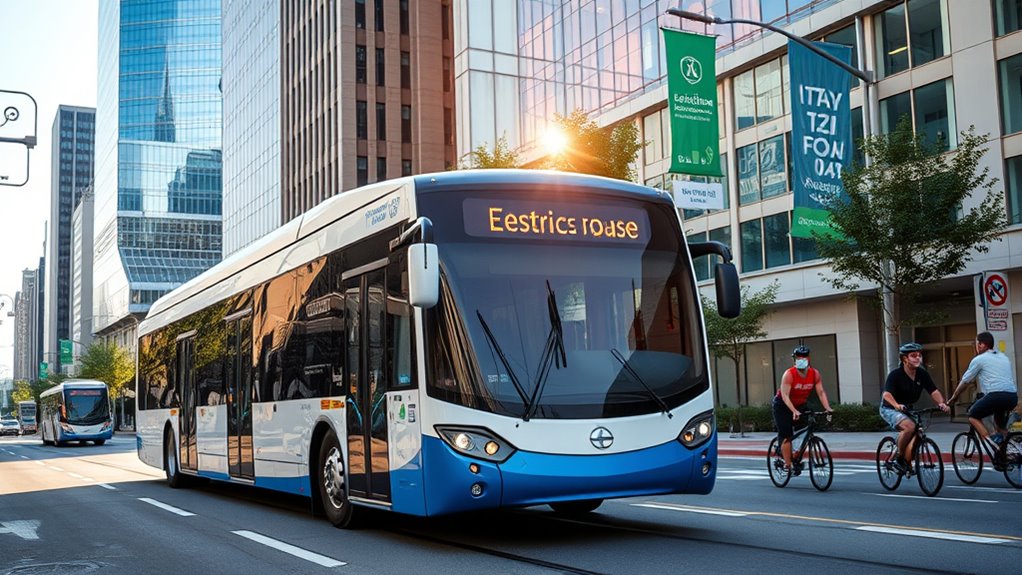
Policy measures play a crucial role in accelerating the shift toward sustainable transit by providing the necessary infrastructure, incentives, and regulations. Federal funding, like the $700 million in infrastructure grants, helps expand EV charging networks, while tax credits lower upfront costs for EV purchases and charging hardware. Incorporating nutritional benefits of green juice exemplifies the importance of supporting healthy, sustainable choices alongside transportation initiatives.
Executive Orders, such as requiring federal fleets to be 100% zero-emission by 2035, set clear targets, complemented by state matching programs that amplify funding. Zero-emission vehicle mandates, including sales phaseouts and manufacturer quotas, push industry adoption. Supporting infrastructure is essential for widespread electric bus adoption, ensuring that charging stations are accessible and reliable for transit agencies. Additionally, developing electric vehicle charging networks that are integrated into urban planning can significantly enhance the feasibility of electric transit.
Equity-focused policies, like Washington’s TES, ensure benefits reach frontline communities, and workforce training programs support a just transition. Additionally, grid upgrades, public-private partnerships, and interagency coordination further bolster infrastructure and policy alignment, driving widespread adoption of electric transit solutions.
Market Trends Shaping the Future of Electric Buses

The electric bus market is experiencing rapid growth driven by technological innovations, declining costs, and increasing demand for sustainable transportation. Market size projections vary from $17 billion to over $64 billion in 2024, with estimates reaching up to $188 billion by 2032.
The electric bus market is rapidly expanding due to innovation, cost reductions, and rising demand for sustainable transit.
A compound annual growth rate of around 14–15% reflects strong momentum across regions. Asia Pacific leads production and adoption, thanks to Chinese OEMs like BYD and Yutong, supported by government subsidies.
Europe’s registrations surged 53% in 2023, while North America shows the highest regional growth rate, fueled by federal incentives.
Advances in battery technology, lower operational costs, and expanding charging infrastructure continue to accelerate adoption worldwide. Best Beaches regional preferences and innovations are also influencing market dynamics, shaping a dynamic, expanding market focused on sustainability and efficiency.
Societal Benefits of Integrating Electric Buses Into Urban Life
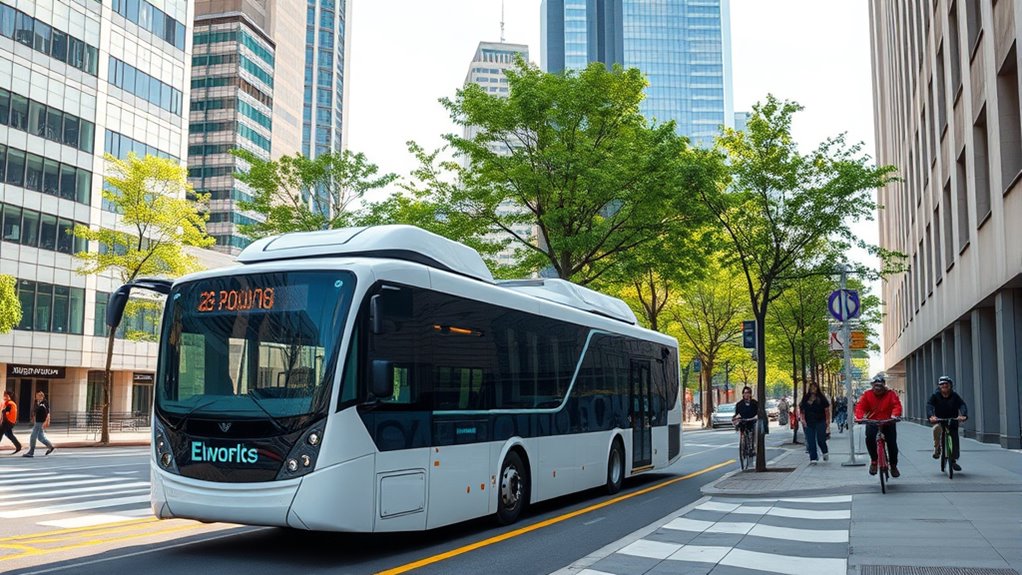
Integrating electric buses into urban life offers numerous societal benefits that enhance both environmental quality and residents’ well-being. You’ll notice improved air quality as electric buses reduce harmful emissions, leading to better public health and fewer respiratory issues. Their quieter operation decreases noise pollution, making city streets more livable and boosting residents’ quality of life. Cities like Oslo and Santiago have already seen cleaner air and health improvements. Electric buses also strengthen city images as modern, eco-friendly places, encouraging ridership and social cohesion. Economically, they lower operational costs and fuel expenses while creating green jobs and attracting investments. Additionally, the adoption of electric buses supports advanced battery technology, which is vital for expanding sustainable transportation options. The integration process also benefits from understanding dynamic communication exercises that can improve coordination among city planners, operators, and the community. These benefits promote sustainable urban development, making cities healthier, more attractive, and better aligned with long-term environmental goals. As cities continue to innovate, implementing effective stakeholder engagement can ensure smoother transitions and broader community support.
Challenges and Opportunities in Infrastructure Development
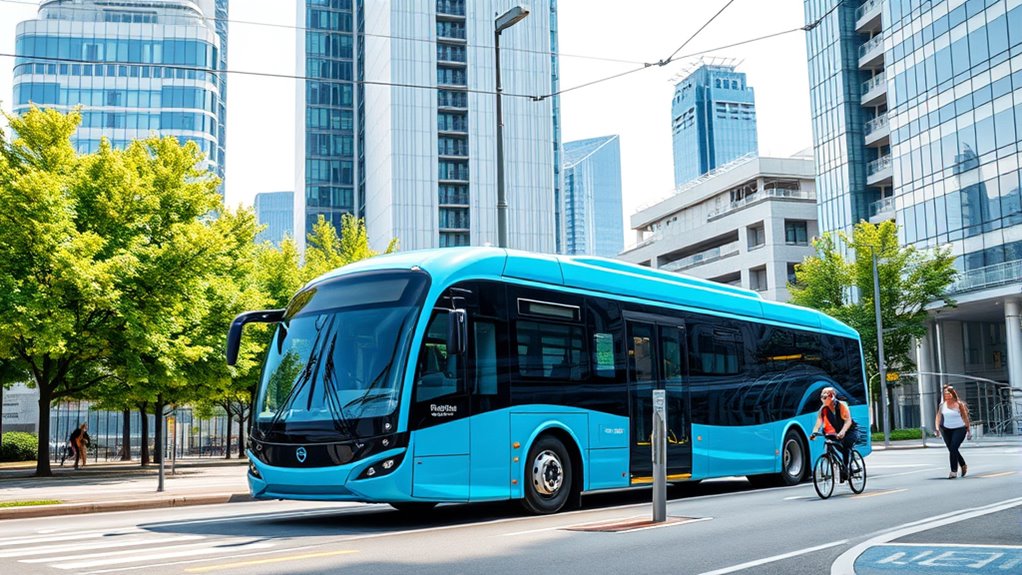
Developing charging infrastructure for electric buses presents several significant challenges, especially as cities endeavor to expand their electric fleets. High-power charging stations are in demand for heavy-duty vehicles, which strains existing power grids.
If you prioritize vehicle procurement over infrastructure, you risk inefficiencies, like needing two e-buses to match one diesel bus’s service. Variability in electricity rates complicates operational planning and cost management.
Additionally, urban areas often require grid upgrades to support increased charging demands, limiting infrastructure deployment. Limited charging options reduce buses’ range and efficiency, especially in underserved areas. Incorporating smart grid management solutions can help optimize energy distribution and improve system resilience. Moreover, implementing real-time monitoring of charging stations can assist operators in managing load demands and preventing outages.
Furthermore, integrating crochet kits for beginners into planning phases can foster community engagement and support workforce development, ensuring local populations are equipped to maintain new infrastructure. Opportunities exist through integrated planning, innovative charging technologies, and collaboration with government and private partners. Strategic investments and policies can accelerate infrastructure growth, supporting long-term decarbonization and sustainable urban transit. Furthermore, AI security solutions can be employed to optimize grid management and protect critical infrastructure from cyber threats, ensuring reliable and secure charging operations.
Regional Leaders and Global Growth in Electric Bus Markets
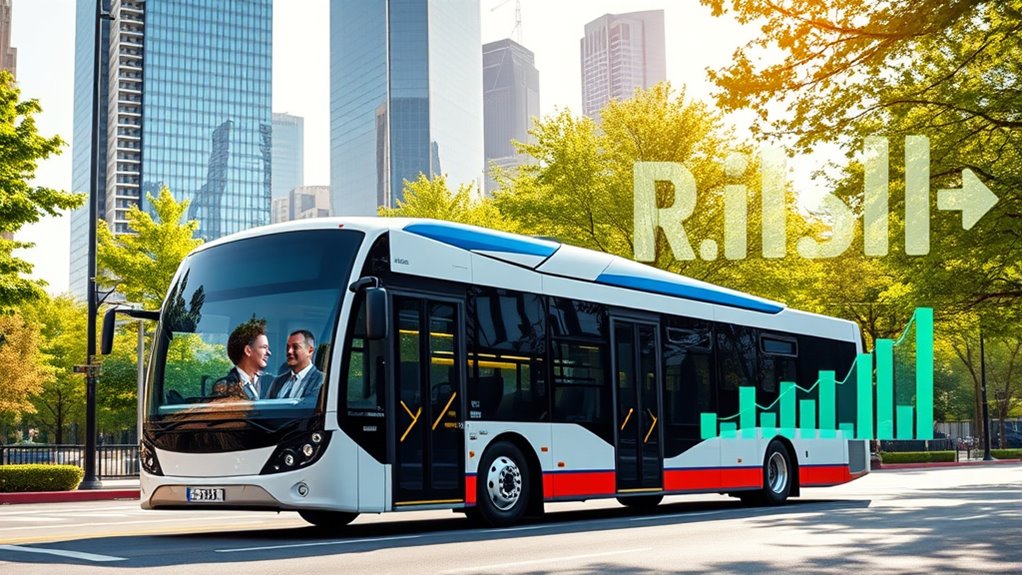
Asia Pacific leads the global electric bus market, accounting for over 98% of sales in 2023, mainly due to manufacturers like BYD and Yutong. China dominates, with about 99% of regional market share, driven by aggressive electrification targets and government policies. The region’s Ford Tuning industry has also benefited from technological advancements, supporting overall vehicle electrification efforts. India is emerging as a key player, supported by federal subsidies under the FAME-II scheme. Production hubs in China, South Korea, and Japan help keep manufacturing costs low. Global market projections show rapid growth, with values reaching over $15 billion in 2024 and expected to surpass $65 billion by 2034. Public transit electrification, government incentives, and advances in battery tech fuel this expansion. Regions like North America, Europe, Southeast Asia, and the Middle East also present strong growth opportunities, driven by policy support and urban sustainability initiatives.
Electric Buses as Catalysts for Broader Sustainable Transportation
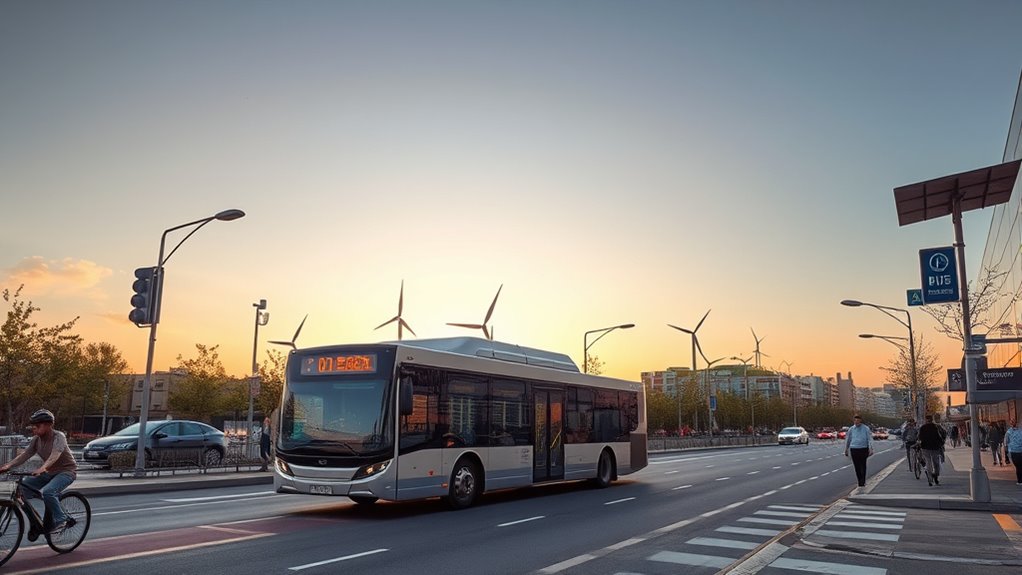
Electric buses are transforming urban transportation by serving as crucial drivers of broader sustainability goals. They substantially cut greenhouse gas emissions, potentially eliminating over 2 million tons annually in the U.S., and improve air quality by reducing particulate pollution and ground-level ozone formation.
These buses also lower noise pollution, creating more peaceful cities. Thanks to advancements in battery technology and regenerative braking, electric buses deliver efficient performance and longer battery life, while newer charging systems support widespread adoption.
Economically, they reduce operational costs by about 50%, with lower maintenance and fuel expenses, offering long-term savings. Policy support and infrastructure development are essential to their integration, helping cities meet environmental targets.
Ultimately, electric buses foster healthier communities, cleaner air, and a more sustainable urban transportation system.
The Role of Community Engagement and Public Perception
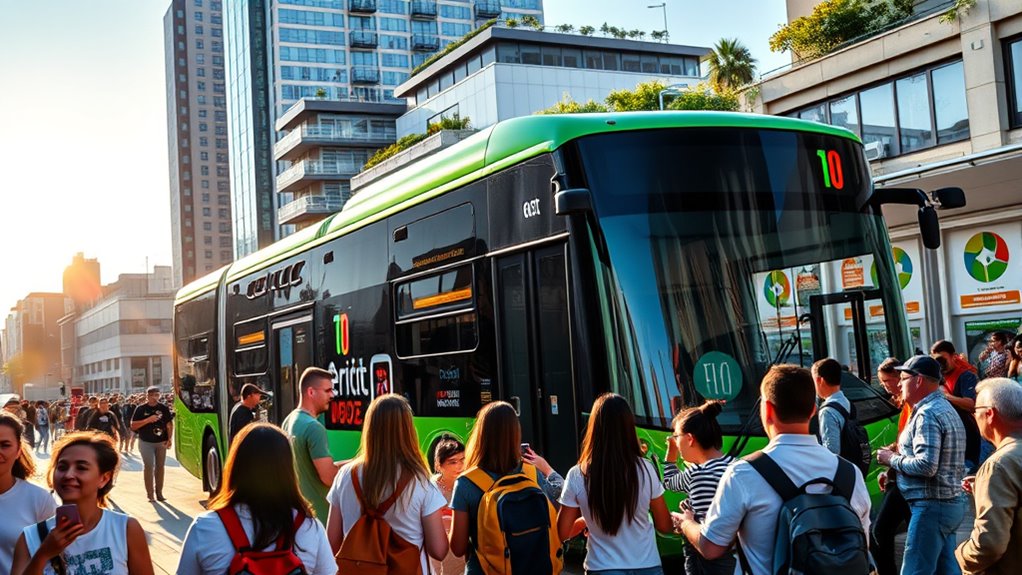
How does community engagement shape the adoption of electric buses? When grassroots groups and parents advocate for cleaner transportation, they influence policy decisions and funding allocations. Campaigns like “Clean Buses for Healthy Niños” and petitions pressure districts to prioritize electric buses, citing health and safety benefits.
Student-led projects and local partnerships with utilities build momentum, demonstrating community support. Public testimonies and educational campaigns raise awareness, reducing skepticism about costs and infrastructure needs.
Community involvement also drives policy changes, such as mandates and grants, by showcasing widespread backing. High participation at forums and media coverage of youth projects accelerate district adoption.
Ultimately, active community engagement fosters trust, promotes positive perception, and catalyzes the shift toward sustainable, electric transportation.
Frequently Asked Questions
How Do Electric Buses Compare to Hybrid and Hydrogen Fuel Cell Buses?
You’ll find electric buses are more efficient and cost-effective than hydrogen fuel cell buses, with higher efficiency and lower operating costs.
Compared to hybrid buses, electric models produce zero emissions and have simpler systems, but hybrids offer more flexibility for different routes.
Hydrogen buses are less efficient and more expensive to operate, mainly due to infrastructure and maintenance needs.
What Are the Main Challenges in Scaling Electric Bus Infrastructure?
You face several challenges when scaling electric bus infrastructure. The high upfront costs of buses and charging stations can strain budgets.
Limited charging points and variable battery ranges complicate scheduling and reliability.
You also need to manage fluctuating electricity rates and guarantee the grid can handle increased demand.
Additionally, training staff and integrating new systems require time and resources, making the shift complex but essential for sustainability goals.
How Can Cities Effectively Fund Electric Bus Adoption Programs?
To effectively fund electric bus adoption programs, you should leverage federal programs like the Clean School Bus Program and EPA rebates that reduce upfront costs.
Tap into state and local incentives, form utility partnerships for infrastructure support, and explore third-party financing options like leasing.
Conduct thorough infrastructure assessments, educate stakeholders, and use data to prioritize high-impact areas.
Applying for grants with strong support increases your chances of securing funding.
What Strategies Improve Public Acceptance of Electric Transit Options?
You can improve public acceptance of electric transit options by launching innovative marketing campaigns that emphasize environmental and health benefits. Engage communities with bus demonstrations and educational programs, including schools.
Use social media and influencers to spread awareness widely. Make charging convenient with fast, accessible stations, and guarantee seamless integration into existing transit systems.
Offering incentives like subsidies and tax benefits also encourages more people to embrace electric buses confidently.
How Do Electric Buses Influence Overall Urban Transportation Planning?
You see, electric buses shape urban transportation planning by prompting cities to rethink infrastructure, zoning, and energy needs.
You’ll need to plan charging stations carefully, considering depot locations and grid capacity.
They also influence urban design, encouraging quieter, cleaner neighborhoods.
By reducing emissions and noise, electric buses support more walkable, livable cities.
You’ll balance operational costs and infrastructure investments, creating more efficient, sustainable transit systems that meet both environmental goals and public demand.
Conclusion
Imagine stepping onto an electric bus and feeling the cool, quiet ride—like gliding on a wave of change. Just as a single ripple can create a tidal shift, your choice to support electric buses accelerates our shift toward sustainable transit. With over 700,000 electric buses worldwide and falling costs, you’re part of a movement transforming cities into cleaner, healthier places. Together, we’re driving toward a future where every mile is greener and brighter.
